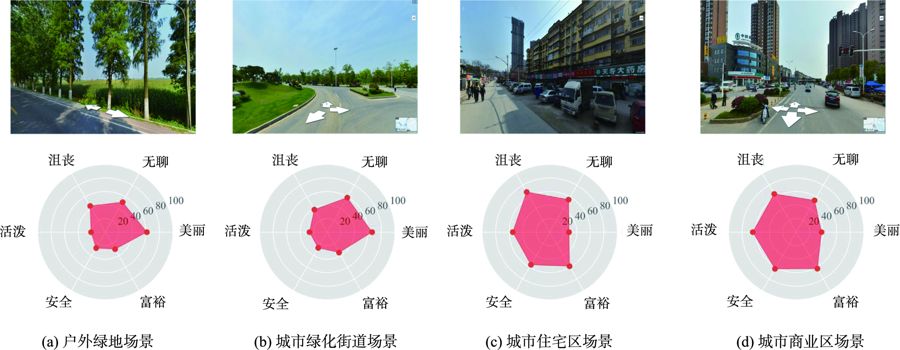

基于街景图像的可解释性城市感知模型研究方法
|
刘智谦(1997— ),男,四川达州人,硕士生,研究方向为城市计算和空间分析。E-mail: liuzhiqian@cug.edu.cn |
收稿日期: 2021-11-05
修回日期: 2022-01-20
网络出版日期: 2022-12-25
基金资助
国家自然科学基金项目(41671408)
国家自然科学基金项目(41901332)
国家重点研发计划项目(2019YFB2102903)
湖北省自然科学基金项目(2017CFA041)
Research Method of Interpretable Urban Perception Model based on Street View Imagery
Received date: 2021-11-05
Revised date: 2022-01-20
Online published: 2022-12-25
Supported by
National Natural Science Foundation of China(41671408)
National Natural Science Foundation of China(41901332)
National Key Research and Development Program of China(2019YFB2102903)
Natural Science Fund of Hubei Province(2017CFA041)
理解城市环境对人类感知的影响,对城市合理规划及布局具有重要的人文参考价值。城市环境是一个动态变化的复杂系统,具有空间异质性的特点。由于研究方法的限制,在复杂的城市环境中,以往基于街景图像的城市感知研究难以全面精细地分析环境关键要素对人类感知的影响。本研究以武汉市中心为研究区,首先利用全卷积神经网络将街景图像分割为城市地物类型,耦合感知打分数据和随机森林算法建立6类城市感知模型;然后基于沙普利值方法分解在随机森林模型中各类城市地物对人类感知的影响,并识别城市环境关键要素;最后结合分解结果,探究在非线性模型中沙普利值方法的适用性和优势。结果表明:沙普利值方法能够有效考虑环境异质性,精确地定量表示在不同场景中各类地物对人类感知的影响;城市高楼、天空、绿地空间是对人类感知影响最大的3类地物,且地物的体积和分布与其对人类感知的影响有关,图像占比大、分布连续的地物对人类感知的影响比图像占比小、分布离散的地物对人类感知的影响大;受城市环境空间异质性的影响,主要地物类型对各类感知的影响程度和形式有显著不同;高楼与人类感知为非线性关系,且具有明显的单调递增或递减的形式;绿地空间与积极感知呈非线性关系,与消极感知呈线性递减的关系。基于可解释性方法,本研究主要分析城市环境关键要素对人类感知的影响特点,探究了城市感知模型中的可解释性问题,能够为城市感知相关研究提供方法参考和理论依据,同时也可为城市规划和景观设计提供参考。

刘智谦 , 吕建军 , 姚尧 , 张嘉琪 , 寇世浩 , 关庆锋 . 基于街景图像的可解释性城市感知模型研究方法[J]. 地球信息科学学报, 2022 , 24(10) : 2045 -2057 . DOI: 10.12082/dqxxkx.2022.210712
Understanding the impact of urban environment on human perception has important humanistic reference value for rational urban planning and layout. The urban environment is a dynamic and complex system with spatial heterogeneity. Due to the limitations of research methods in the complex urban environment, it is difficult to analyze the impact of key elements of the environment on human perception comprehensively and precisely in previous urban perception studies based on street view images. In this study, the center of Wuhan is chosen as the research area. First, the street view images are segmented into urban ground objects by using Fully Convolutional Networks, coupled with perception scoring data and Random Forests algorithm to establish six types of urban perception models. Then, based on the Shapley value method, the impact of various urban ground objects on human perception in the forest model is decomposed, and the key elements of the urban environment are identified. Finally, combined with the decomposition results, the applicability and advantages of the Shapley value method in the nonlinear model are explored. The results show that the Shapley value method can effectively consider the spatial heterogeneity of urban physical environment and accurately and quantitatively express the impact of various ground objects on human perception in different scenarios. Urban buildings, sky, and green space are the three categories that have the greatest degree of impact on human perception. And the volume and distribution form of ground objects affects human intuitive visual experience of ground objects, which in turn affects the specific impact role of ground objects on human perception. The larger the image proportion of the ground objects or the more continuous the distribution of the ground objects, the greater the impact of ground objects on human perception. At the same time, because of the influence of the spatial heterogeneity of the urban physical environment, the impact degree and form of the main ground object types on various perceptions are significantly different. The relationship between buildings and human perception is nonlinear and has an obvious monotonically increasing or decreasing form. Green space has a nonlinear relationship with positive perception and a linear decreasing relationship with negative perception. Based on the interpretability approach, this study analyzes the impact of key elements of urban environment on human perception and explores the interpretability issues in urban perception models, which can provide methodological reference and theoretical basis for urban perception related research, as well as reference for urban planning and landscape design.

表2 14种地物类型及其图像数据汇总统计Tab. 2 Summary statistics of imagery data for fourteen kinds of ground objects |
| 地物类别 | 地物中文名称 | 出现次数/% | 占比均值/% |
|---|---|---|---|
| 自然地物 | 草 | 77.714 | 1.428 |
| 植物 | 80.101 | 1.547 | |
| 天空 | 99.936 | 29.180 | |
| 树 | 98.865 | 14.207 | |
| 人工地物 | 围栏 | 90.553 | 1.294 |
| 地面 | 77.883 | 1.624 | |
| 指示物 | 56.249 | 0.060 | |
| 人行道 | 92.127 | 2.614 | |
| 广告牌 | 84.955 | 0.337 | |
| 路灯 | 69.736 | 0.046 | |
| 道路 | 99.545 | 18.430 | |
| 机动汽车 | 90.223 | 2.553 | |
| 墙 | 91.250 | 2.042 | |
| 高楼建筑 | 98.929 | 14.951 |
表3 6种感知模型的拟合精度Tab. 3 Fitting accuracy of six emotion perception models |
| 感知类型 | R2 | RMSE | MAE |
|---|---|---|---|
| 美丽 | 0.925 | 2.807 | 2.073 |
| 无聊 | 0.855 | 2.310 | 1.746 |
| 沮丧 | 0.974 | 1.680 | 1.258 |
| 活泼 | 0.935 | 3.320 | 2.491 |
| 安全 | 0.947 | 2.518 | 1.900 |
| 富裕 | 0.953 | 2.490 | 1.852 |
| [1] |
|
| [2] |
张丽英, 裴韬, 陈宜金, 等. 基于街景图像的城市环境评价研究综述[J]. 地球信息科学学报, 2019, 21(1):46-58.
[
|
| [3] |
|
| [4] |
|
| [5] |
|
| [6] |
|
| [7] |
|
| [8] |
|
| [9] |
|
| [10] |
|
| [11] |
|
| [12] |
崔成, 任红艳, 赵璐, 等. 基于街景影像多特征融合的广州市越秀区街道空间品质评估[J]. 地球信息科学学报, 2020, 22(6):1330-1338.
[
|
| [13] |
|
| [14] |
|
| [15] |
|
| [16] |
|
| [17] |
|
| [18] |
|
| [19] |
|
| [20] |
陈逸敏, 黎夏. 机器学习在城市空间演化模拟中的应用与新趋势[J]. 武汉大学学报·信息科学版, 2020, 45(12):1884-1889.
[
|
| [21] |
|
| [22] |
|
| [23] |
|
| [24] |
|
| [25] |
|
| [26] |
|
| [27] |
|
| [28] |
|
| [29] |
|
| [30] |
|
| [31] |
|
| [32] |
| [33] |
|
| [34] |
|
| [35] |
|
| [36] |
|
| [37] |
|
| [38] |
|
| [39] |
|
| [40] |
|
| [41] |
|
| [42] |
|
/
| 〈 |
|
〉 |